Attacus atlas
| Atlas moth | |
|---|---|
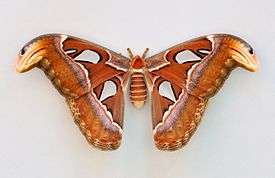 | |
| Atlas moth (female) | |
| Scientific classification | |
| Kingdom: | Animalia |
| Phylum: | Arthropoda |
| Class: | Insecta |
| Order: | Lepidoptera |
| Family: | Saturniidae |
| Genus: | Attacus |
| Species: | A. atlas |
| Binomial name | |
| Attacus atlas | |
Attacus atlas (Atlas moth) is a large saturniid moth endemic to the forests of Asia.
Description
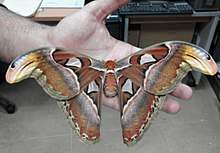
Atlas moths are one of the largest lepidopterans in the world with a wingspan measuring between 25–30 cm (9.8–11.8 in) and a wing surface area of about 400 cm2 (62 in2). It is only surpassed in wingspan by the white witch (Thysania agrippina) and in wing surface area by the Hercules moth (Coscinocera hercules). Females are noticeably larger and heavier than males, while males have broader antennae.[1][2][3]
The body is disproportionately small compared to the wings. The upper side of the wings are reddish-brown with a pattern of black, white, pink, and purple lines and triangular, scale-less windows bordered in black. The undersides of the wings are paler. Both forewings have a prominent extension at the top.[4]
Habitat

Their habitat is primarily dry rainforests, secondary forests, and shrublands across South Asia, East Asia, and Southeast Asia, including Borneo.[5]
Etymology
Atlas moths are named after either the Titan of Greek mythology (due to their size) or their map-like wing patterns. In Hong Kong, the Cantonese name translates as "snake's head moth," referring to the prominent extension of the forewing which bears resemblance to the head of a snake.[6]
Life cycle
| Holometabolism (complete metamorphosis) | ||||
|---|---|---|---|---|
 |
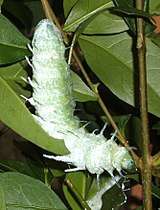 |
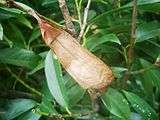 |
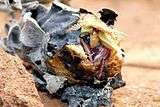 |
 |
| Eggs | Larva | Pupa within cocoon | Emerging from pupa | Imago |
Mating
Females are sexually passive, releasing powerful pheromones through a gland on the end of the abdomen to attract a mate. The female does not stray far from the location of her discarded cocoon. She seeks out a perch where the air currents will best carry her pheromones. Males can detect and home in on these pheromones from several kilometers away using chemoreceptors located on their feathery antennae.[7] Once fertilized, the female lays a number of spherical eggs, 2.5 mm (0.098 in) in diameter, on the undersides of the leaves of food plants.
Larva
Dusty-green caterpillars hatch after approximately two weeks and feed voraciously on the foliage of citrus, cinnamon, guava, and evergreen trees.[8] The caterpillars can grow to 11.5 cm (4.5 in) in length and 2.5 cm (0.98 in) in thickness. They are adorned with white, waxy, fleshy spines along their backs, which become more prominent at later instars. Beside the prolegs on the last abdominal segment, there is a large green spot surrounded by an orange ring.
Pupa
After reaching a length of about 11.5 cm (4.5 in), the caterpillars are ready to pupate. They spin a 7-8 cm long papery cocoon interwoven with desiccated leaves and attach it to a twig using a strand of silk. The adult moths emerge from the cocoon after approximately four weeks.
Imago
.jpg)
Adult Atlas moths are weak, unsteady fliers. To conserve energy, the moths rest during the day and fly at night. They fly throughout the year but are most abundant between November and January. The adults lack fully formed mouthparts and cannot eat, subsisting entirely on fat reserves accumulated during the larval stage. As a result, they live for only a few days during which their sole objective is seeking out a mate.
Relationship with humans
In India, Atlas moths are cultivated for their silk in a non-commercial capacity. Unlike silk produced by the related domestic silkmoth (Bombyx mori), Atlas moth silk is secreted as broken strands and is therefore less desirable. This brown, wool-like silk, known as fagara, is thought to have greater durability.[9] Atlas moth cocoons are sometimes used as small pocket change purses in Taiwan.[10]
The Japanese subspecies A. a. ryukyuensis, native to Yonaguni in the Yaeyama Islands, may have served as inspiration for the movie monster Mothra.
Similar taxa
The term "Atlas moth" is sometimes used mistakenly as a name for any species in the genus Attacus, of which there are over 20 named species and subspecies. Attacus taprobanis[11] native to southern India and Sri Lanka[12] is very similar in morphology to the much more widely distributed Attacus atlas. It was once considered a subspecies of A. atlas.[13] A few New World species can be mistaken for Atlas moths, specifically members of the genus Rothschildia. Very similar in appearance to the Asian Atlas moth, Rothschildia aurota is one of the largest members of its genus and a neotropical relative.
References
- ↑ Watson, A. & Whalley, P.E.S. (1983). The Dictionary of Butterflies and Moths in colour. Peerage Books, London, England. ISBN 0-907408-62-1
- ↑ Robert G. Foottit & Peter H. Adler. 2009. Insect Biodiversity: Science and Society. Blackwell Publishing Ltd. ISBN 978-1-405-15142-9
- ↑ Rainier Flindt. 2006. Amazing Numbers in Biology. Springer-Verlag, Berlin. ISBN 3-540-30146-1
- ↑ WAZA. "Atlas Moth - Attacus atlas : WAZA : World Association of Zoos and Aquariums". www.waza.org. Retrieved 2018-04-05.
- ↑ Holloway, J.D. (1987). The Moths of Borneo, part 3: Lasiocampidae, Eupteroptidae, Bombycidae, Brahmaeidae, Saturniidae, Sphingidae. Southdene Sdn. Bhd., Kuala Lumpur
- ↑ Yiu, V. (2006). Insecta Hongkongica. Hong Kong Discovery. Kowloon, Hong Kong. 655pp. ISBN 988-97173-9-5
- ↑ Shepherd, G.M. (1994). "Chemical Senses". In Neurobiology 3rd Edition. Oxford University Press
- ↑ Robinson, G.S., Ackery, P.R., Kitching, I.J., Beccaloni, G.W. & Hernández, L.M. (2001). Hostplants of the moth and butterfly caterpillars of the Oriental Region. Southdene Sdn. Bhd., Kuala Lumpur & The Natural History Museum, London. 744 pp. ISBN 983-40053-3-4
- ↑ Jolly, M.S., Sen, S.K., Sonwalkar, T.N. & Prasad, G.S. (1979). Non-mulberry silks. Food & Agriculture Organisation. United Nations, Serv. Bull. 29. Rome. xvii + 178pp
- ↑ S. B. Jugale; et al. (2010). "MAJOR INSECT PESTS OF XYLOCARPUS GRANATUM KOEN., A CRITICALLY ENDANGERED MANGROVE SPECIES OF MAHARASHTRA" (PDF). ISSN 0973-7049.
- ↑ Moore, Frederic (1880). The Lepidoptera of Ceylon. Vol. II. London: L. Reeve & co. pp. 124–125.
- ↑ Peigler, Richard S. (1989). A revision of the Indo-Australian genus Attacus (Lepidoptera: Saturniidae). Lepidoptera Research Foundation. ISBN 0961146427. Retrieved 5 June 2018.
- ↑ Savela, Markku. "Attacus Linnaeus, 1767". Lepidoptera - Butterflies and Moths. Retrieved 2018-03-17.
External links
| Wikimedia Commons has media related to Attacus atlas. |
| Wikispecies has information related to Attacus atlas |
